修辞格翻译(2)
翻译、修辞格

Байду номын сангаас
七、省略(Ellipsis)
─她会来吗? ─她可能会(来),她会(来)的,但 也可能不会(来)。 ─Is she going to come? ─She might _____,she is to (come) (come ) she may not _____. (come) _____but
第二节 意译的修辞格
一、拟声 (Onomatopoeia/ˌɒnəˌmæ təˈpiːə /) 二、对偶(antithesis) 三、双关( Pun) 四、顶真(anadiplosis) 五、脚韵(Rhyme) 六、拈连(zeugma ['zjuːgmə] ) 七、借代(antonomasia) 八、摹形(Graphic) 九、列锦
一、拟声 (Onomatopoeia/ˌɒnəˌmæ təˈpiːə /)
也有一些中英文对应的拟声词 咯咯地笑 ──giggle 流水潺潺 ── babble ── hiss 嘶嘶地 喵喵地叫 ── meow 咕咕地叫 ── cuckoo
骄阳下,柳树下,回答他的是一片 rattle ──尖利声 crack ──爆裂声 “知了,知了”的蝉叫声。 rumble ──隆隆声 Under the scorching sun from the 哧哧作响 ──,sizzle 沙沙声 ── rustle willow tree , came the confirming reply 雨滴声── spatter of the cicada's chirrup:"(I) see, (I) see …’’
九、递升(Climax)
定义:把事物由小到大、由长到短、由 低到高、由轻到重等的次序说下去。
修辞格的翻译方法
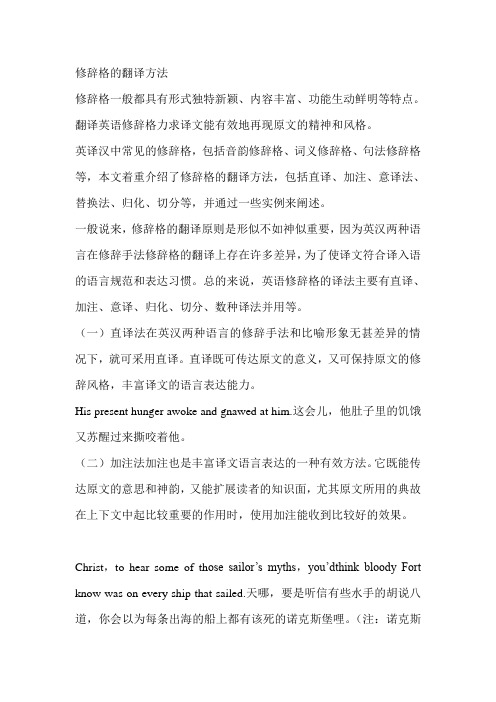
修辞格的翻译方法修辞格一般都具有形式独特新颖、内容丰富、功能生动鲜明等特点。
翻译英语修辞格力求译文能有效地再现原文的精神和风格。
英译汉中常见的修辞格,包括音韵修辞格、词义修辞格、句法修辞格等,本文着重介绍了修辞格的翻译方法,包括直译、加注、意译法、替换法、归化、切分等,并通过一些实例来阐述。
一般说来,修辞格的翻译原则是形似不如神似重要,因为英汉两种语言在修辞手法修辞格的翻译上存在许多差异,为了使译文符合译入语的语言规范和表达习惯。
总的来说,英语修辞格的译法主要有直译、加注、意译、归化、切分、数种译法并用等。
(一)直译法在英汉两种语言的修辞手法和比喻形象无甚差异的情况下,就可采用直译。
直译既可传达原文的意义,又可保持原文的修辞风格,丰富译文的语言表达能力。
His present hunger awoke and gnawed at him.这会儿,他肚子里的饥饿又苏醒过来撕咬着他。
(二)加注法加注也是丰富译文语言表达的一种有效方法。
它既能传达原文的意思和神韵,又能扩展读者的知识面,尤其原文所用的典故在上下文中起比较重要的作用时,使用加注能收到比较好的效果。
Christ,to hear some of th ose sailor’s myths,you’dthink bloody Fort know was on every ship that sailed.天哪,要是听信有些水手的胡说八道,你会以为每条出海的船上都有该死的诺克斯堡哩。
(注:诺克斯堡是美国一个军事保留地,是美国黄金仓库的所在地。
)(三)意译法由于许多英语修辞手法或比喻形象本身是特有的,如保留其形象就会危害其义。
如英语的头韵法,其搭配可以千变万化,很难碰巧找到这样的汉语搭配,即使勉强凑韵,也不一定能表达原文的意思。
在这种情况下,必须首先保证译文能正确传达原文的思想内容,然后尽一切可能去表现原文的节奏和旋律。
safe and sound安然无恙now and never机不可失(1)He is the mouth of the House in its relations with the crown.他是议会对王室的发言人。
修辞格与翻译

12
❖What salt is to food, wit and humor are to conversation and literature.
4
1. Simile (明喻)
❖A simile is a figure of speech which makes a comparison between two unlike elements having at least one quality or characteristic in common.
❖ 妙语与幽默对于会话与文学,恰似盐对于食物一 样。
❖What sculpture is to a block of marble, (that) education is to the soul.
❖ 教育之于心灵,犹如雕刻之于大理石。 ❖What blood vessel is to a man’s body, (that)
14
2. Metaphor (暗喻;隐喻)
❖A metaphor also makes a comparison between two elements, but unlike simile, this comparison is implied rather than stated.
❖Metaphor 借自希腊语metapherein一词,原意 为transfer (转换)。它也是一种比喻手法,但 是形式简练,表达含蓄,无需借助比喻词,而是 直接将甲事物当作乙事物来描写。
修辞格翻译

拟人(Personification) 拟人(Personification)
拟人就是把动物和没有生命的事物当成有思想感 情的人类来描写,甚至让它们具有人的行为。这 些事物可以是无生命的实体,还可以是抽象的概 念, 如:a smiling moon(微笑的月亮),a 如:a moon(微笑的月亮),a crying city(哭泣的城市),to strangle justice city(哭泣的城市),to (扼杀正义)等。 英汉两种语言中都有这种修辞手法,在翻译的时 候一般可采取直译的方法再现原文的生动形象。
3)We must work to live, and they give us such mean wages that we die. (Oscar Wilde, The Young King) King) 我们不得不做工来养活自己,可是他们只给我们那么少的 工钱,我们简直活不下去。 (巴金译) 4)Nay, he said—yes you did—deny it if you can, that said— did— you would not have confessed the truth, though master had cut you to pieces. (Henry Fielding, The History of Tom Jones, A Foundling) Foundling) 他还说——你是这么说的,有本事你就抵赖好了。你还说, 他还说——你是这么说的,有本事你就抵赖好了。你还说, 就是老师把你剁成肉酱,你也绝不招出实情。(萧乾译)
修辞格翻译(2 修辞格翻译(2)
转喻(Metonymy) 转喻(Metonymy)
转喻就是借与人或事物有关联的事物来指代人或事物。根 据上下文,既可以直译,也 可以意译。首先请看下面的例句: 1)Is life so dear, or peace so sweet, as to be purchased at the price of chains and slavery? 生命当真如此可贵,和平当真如此甜蜜,竟值得以枷锁和 奴役为代价去换取吗? 在这里,chains(枷锁)指代“束缚”,直译既可以保留 在这里,chains(枷锁)指代“束缚”,直译既可以保留 原文的感染力,又可以为读者理解。但并不是在所有情况 下直译都是最好选择,例如:John 下直译都是最好选择,例如:John spent many years in chains beforehe saw his family again. Chains 在这里指 代“囚禁”,若译成“约翰在枷锁中过了许多年才又见到 他的家人”则嫌不够自然,可意译成“约翰在监牢里呆了 很多年才又见到他的家人”。
英语修辞学中20种常见修辞格名称双语释义及举例
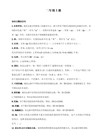
What does that lawyer do after he dies?——Lie still. 那个律师死后干什么?──躺着仍说鬼话。(注:lie躺, 撒谎;still安静地, 仍然)
E. oxymoron; zeugma ; contrast
Oxymoron(矛盾修辞法)与汉语中的反映辞格类似,都是将相互矛盾的概念和判断巧妙地联系在一起,以便相互映衬,突出事物的特点,表达复杂的思想感情和意味深长的哲理。矛盾修辞手法在英语中常见,但在汉语中很少见。如:sweet sorrow 忧喜参半 (不是甜蜜的悲伤); proud humility 不卑不亢(不是骄傲的谦卑)
这个项目从一开始就是一个摆脱不了的经济难题。(Albatross是英国诗人柯勒律治的《古舟子咏》中的信天翁,它被忘恩负义的水手杀死后,全船陷入灾难中。)
B. metonymy; transferred epithet Metonymy、synecdoche和_1antonomasia都是不直接说出事物的本来名称,而换用另一个名称或另一个说法。它们大体上相当于汉语的借代(分为旁借和对代两类)。如Crown(王冠)可喻指君主、王权、王国政府等;doll(玩具)可喻指姑娘、宝贝等。再如:
as thick as thieves亲密无间(不是"像贼一样厚")
as old as the hills古老 (不是"像山一样老")
The ship plows the sea. 船在乘风破浪地前进。(不是"船在犁海")
Allusion与汉语的暗引相近似。其特点是不注明来源和出处,一般多引用人们熟知的关键词或词组,将其融合编织在作者的话语中。引用的东西包括典故、谚语、成语、格言和俗语等。英语引用最多的是源出《圣经》故事以及希腊、罗马神话、《伊索寓言》和那些渊源流长的谚语、格言等。例如:
第九讲 修辞格的翻译2

双关;Pun
1)美国作家海明威的小说名 A Farewell to Arms 中的 “arms”一语双关,第一层意思为 “武器”, 代表帝国主义战争,第二层意思为 “手臂”,代表 拥抱与爱情,该词点出了他这部作品的双重主题。 此书有两个汉译本,一本把书名译为《永别了,武 器》,另一本处理成《战地春梦》,在体现书名里 的双关语这一点上,后一种译法更为恰切:“战” 与 “春”分别译出原文 arms 的两层意思。
顶真;Anadiplosis 1) 有个农村叫张家庄 张家庄 张家庄,张家庄 张木匠。 张家庄 张家庄有个张木匠 张木匠 张木匠有个好老婆,外号叫“小飞娥 小飞娥”。小 张木匠 小飞娥 小 飞娥生了个女儿叫艾艾。(赵树理:《登 飞娥 记》)There was a village called Zhangjia Village,where lived Carpenter Zhang,who had a good wife,nicknamed Little Moห้องสมุดไป่ตู้h, who gave birth to a girl called Ai’ai.
脚韵 (Rhyme) 1) 饭来张口,衣来伸手 口 手 have only to open one’s mouth to be fed and hold out one’s hands to be dressed ---- lead an easy life 2) 秦时明月汉时关, 关 万里长征人未还。(王昌龄:《从军行〈之三〉》) 还 The age-old moon still shines o’er the ancient Great Wall, But our frontier guardsmen have not come back at all.
英语常用修辞格的翻译

省略;Ellipsis
eg:妈妈让他洗碗,她就不洗。 译文:Mother tells her to wash the dishes, but she will not(do it)
移就;Transferred Epithet
把本来用以修饰人的形容词移属于同人有关的抽象物 或具体物,这种貌似错误、实为妙用的修辞格叫做 “移就”(Transferred Epithet),它通过词语巧妙 的“移植”,来取得常规搭配所无法得到的效果。
转喻;Metonymy
Biblioteka eg: 秃头站在白背心的略略正对面,弯了腰, 去研究背心上的文字。(鲁迅:《示众》) 译文:Baldy,standing almost directly opposite White Jerkin,stooped to study the characters written on his jerkin. 有时采用意译更为合适 eg: 英雄所见略同。 译文:Great minds think alike.
递升;Climax
把事物按由小到大、由短到长、由低到高、由轻到重、由近 到远、由易到难、由浅到深等次序说下去,这种修辞手法叫 递升,英语里称作 climax。运用这一修辞手法,能够使要表 达的思想逐步加深、感情逐步强化,因而能增强语言的说服 力和感染力。 eg:事情就是这样,他来进攻,我们把他消灭了,他就舒服了。 消灭一点,舒服一点;消灭得多,舒服得多;彻底消灭,彻 底舒服。( 毛泽东:《关于重庆谈判》) 译文:This is the way things are:if they attack and we wipe them out,they will have that satisfaction;wipe out some,some satisfaction;wipe out more,more satisfaction;wipe out the whole lot,complete satisfaction.
英语修辞的翻译

提喻 (synecdoche)
No one grasped you by the shoulder while there was still time; and naught will awaken in you the sleeping poet or musician or astronomer that possibly inhabited you from the begi得目瞪口呆的事。他体内充 满创造力的魔鬼不停地挣扎,挥舞魔爪又抓 又挖,试图冲出体外。魔鬼一边撕扯,一边 尖声狂叫,要他谱写藏于体内的乐曲。他遭 受这般折腾,可是他那可怜的脑袋和身躯却 没有被压跨,岂不奇哉怪也。
双关 (Pun)
--What does that lawyer do after he dies? --Lie still.
矛盾(Oxymoron)
3. Parting is such sweet sorrow. (Romeo) 别离是如此地又甜蜜又令人心酸。
4. We are terribly pleased to hear the good news. 我们听到这一好消息真是欣喜若狂。
委婉(Euphemism)
1. That luster has taken a fancy to Middle Eastern dancing. 那个好色之徒现在开始喜欢看肚皮舞。
也许你一生下来就具有成为诗人、音乐家或天 文学家的天赋,但在时间还不算晚的时候,没 有人拉你一把,时机一过,就再也无法唤醒在 你身上沉睡着的才能了。
转喻(Metonymy)
转喻又称借代。它故意不用需要说的人或 物的本称,而是借用与该人或物密切相关 的事物来代替。
“A figure of speech that consists in using the name of one thing for that of something else with which it is associated.” (Webster’s New World Dictionary)
翻译中常见的修辞格
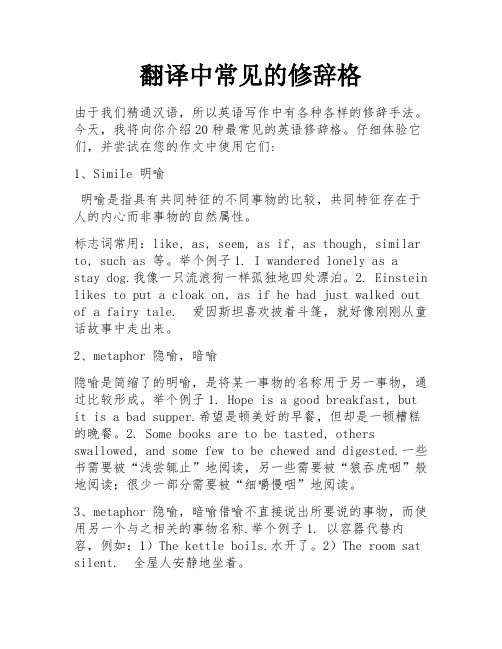
翻译中常见的修辞格由于我们精通汉语,所以英语写作中有各种各样的修辞手法。
今天,我将向你介绍20种最常见的英语修辞格。
仔细体验它们,并尝试在您的作文中使用它们:1、Simile 明喻明喻是指具有共同特征的不同事物的比较,共同特征存在于人的内心而非事物的自然属性。
标志词常用:like, as, seem, as if, as though, similar to, such as 等。
举个例子1. I wandered lonely as astay dog.我像一只流浪狗一样孤独地四处漂泊。
2. Einstein likes to put a cloak on, as if he had just walked out of a fairy tale. 爱因斯坦喜欢披着斗篷,就好像刚刚从童话故事中走出来。
2、metaphor 隐喻,暗喻隐喻是简缩了的明喻,是将某一事物的名称用于另一事物,通过比较形成。
举个例子1. Hope is a good breakfast, but it is a bad supper.希望是顿美好的早餐,但却是一顿糟糕的晚餐。
2. Some books are to be tasted, others swallowed, and some few to be chewed and digested.一些书需要被“浅尝辄止”地阅读,另一些需要被“狼吞虎咽”般地阅读;很少一部分需要被“细嚼慢咽”地阅读。
3、metaphor 隐喻,暗喻借喻不直接说出所要说的事物,而使用另一个与之相关的事物名称.举个例子1. 以容器代替内容,例如:1)The kettle boils.水开了。
2)The room sat silent. 全屋人安静地坐着。
2. 以资料、工具代替事物的名称,例如:Lend me your ears, please. 请听我说。
3. 以代替作品,例如:a plete Shakespeare 莎士比亚全集4. 以具体事物代替抽象概念,例如:I had the muscle, and they made money out of it. 我有力气,他们就用我的力气赚钱。
英语中所有26种修辞手法的全部解释和例句

英语修辞手法总结Figures of speech (修辞)are ways of making our language figurative. When we use words in other than their ordinary or literal sense to lend force to an idea, to heighten effect, orto create suggestive imagery, we are said to be speaking or writing figuratively. Now we are going to talk about some common forms of figures of speech.1) Simile:(明喻)It is a figure of speech which makes a comparison between two unlike elements having at least one quality or characteristic (特性)in common. To make the comparison, words like as, as...as, as if and like are used to transfer the quality we associate with one to the other. For example, As cold waters to a thirsty soul, so is good news from a far country.2) Metaphor:(暗喻)It is like a simile, also makes a comparison between two unlike elements, but unlike a simile, this comparison is implied rather than stated. For example, the worldis a stage.3) Analogy: (类比)It is also a form of comparison, but unlike simile or metaphor which usually uses comparison on one point of resemblance, analogy draws a parallel between two unlike things that have several common qualities or points of resemblance.4) Personification: (拟人)It gives human form of feelings to animals, or life and personal attributes(赋予) to inanimate(无生命的) objects, or to ideas and abstractions(抽象). For example, the wind whistled through the trees.5) Hyperbole: (夸张) It is the deliberate use of overstatement or exaggeration to achieve emphasis. For instance, he almost died laughing.6) Understatement: (含蓄陈述) It is the opposite of hyperbole, or overstatement. Itachieves its effect of emphasizing a fact by deliberately(故意地) understating it,impressing the listener or the reader more by what is merely implied or left unsaid than by bare statement. For instance, It is no laughing matter.7) Euphemism: (委婉) It is the substitution of an agreeable or inoffensive(无冒犯) expression for one that may offend or suggest something unpleasant. For instance, we refer to "die" as " pass away".8) Metonymy (转喻)It is a figure of speech that has to do with the substitution of the mane of one thing for that of another. For instance, the pen (words) is mightier than the sword (forces).9) Synecdoche (提喻) It is involves the substitution of the part for the whole, or thewhole for the part. For instance, they say there's bread and work for all. She was dressedin silks.10) Antonomasia (换喻)It has also to do with substitution. It is not often mentioned now, though it is still in frequent use. For example, Solomon for a wise man. Daniel for a wise and fair judge. Judas for a traitor.11) Pun: (双关语) It is a play on words, or rather a play on the form and meaning of words. For instance, a cannon-ball took off his legs, so he laid down his arms. (Here "arms" has two meanings: a person's body; weapons carried by a soldier.)12) Syllepsis: (一语双叙) It has two connotations.In the first case, it is a figure by which a word, or a particular form or inflection of a word, refers to two or more words in the same sentence, while properly applying to or agreeing with only on of them in grammar or syntax(句法). For example, He addressed you and me, and desired us to follow him. (Here us is used to refer to you and me.)In the second case, it a word may refer to two or more words in the same sentence. For example, while he was fighting , and losing limb and mind, and dying, others stayed behind to pursue education and career. (Here to losing one's limbs in literal; to lose one's mindis figurative, and means to go mad.)13) Zeugma: (轭式搭配) It is a single word which is made to modify or to govern two or more words in the same sentence, wither properly applying in sense to only one of them, orapplying to them in different senses. For example, The sun shall not burn you by day, nor the moon by night. (Here noon is not strong enough to burn)14) Irony: (反语) It is a figure of speech that achieves emphasis by saying the opposite of what is meant, the intended meaning of the words being the opposite of their usual sense. For instance, we are lucky, what you said makes me feel real good.15) Innuendo: (暗讽) It is a mild form of irony, hinting in a rather roundabout (曲折)way at something disparaging(不一致) or uncomplimentary(不赞美) to the person or subject mentioned. For example, the weatherman said it would be worm. He must take his readings in a bathroom.16) Sarcasm: (讽刺) It Sarcasm is a strong form of irony. It attacks in a taunting and bitter manner, and its aim is to disparage, ridicule and wound the feelings of the subject attacked. For example, laws are like cobwebs, which may catch small flies, but let wasps break through.17) Paradox: (似非而是的隽语) It is a figure of speech consisting of a statement or proposition which on the face of it seems self-contradictory, absurd or contrary to established fact or practice, but which on further thinking and study may prove to be true, well-founded, and even to contain a succinct point. For example more haste, less speed.18) Oxymoron: (矛盾修饰) It is a compressed paradox, formed by the conjoining(结合) of two contrasting, contradictory or incongruous(不协调) terms as in bitter-sweet memories, orderly chaos(混乱) and proud humility(侮辱).19) Antithesis: (对照) It is the deliberate arrangement of contrasting words or ideas in balanced structural forms to achieve emphasis. For example, speech is silver; silence is golden.20) Epigram: (警句) It states a simple truth pithily(有利地) and pungently(强烈地). It is usually terse and arouses interest and surprise by its deep insight into certain aspects of human behavior or feeling. For instance, Few, save the poor, feel for the poor.21) Climax: (渐进) It is derived from the Greek word for "ladder" and implies the progression of thought at a uniform or almost uniform rate of significance or intensity,like the steps of a ladder ascending evenly. For example, I came, I saw, I conquered.22) Anti-climax or bathos: (突降)It is the opposite of Climax. It involves stating one's thoughts in a descending order of significance or intensity, from strong to weak, from weighty to light or frivolous. For instance, But thousands die, without or this or that, die, and endow(赋予) a college, or a cat.23) Apostrophe: (顿呼) In this figure of speech, a thing, place, idea or person (dead or absent) is addressed as if present, listening and understanding what is being said. For instance, England! awake! awake! awake!24) Transferred Epithet: (转类形容词) It is a figure of speech where an epithet (anadjective or descriptive phrase) is transferred from the noun it should rightly modify(修饰) to another to which it does not really apply or belong. For instance, I spent sleeplessnights on my project.25) Alliteration: (头韵) It has to do with the sound rather than the sense of words for effect. It is a device that repeats the same sound at frequent intervals(间隔) and since the sound repeated is usually the initial consonant sound, it is also called "front rhyme". For instance, the fair breeze blew, the white foam flew, the furrow followed free.26) Onomatopoeia: (拟声) It is a device that uses words which imitate the sounds made by an object (animate or inanimate), or which are associated with or suggestive(提示的) of some action or movementExplanation version1一、什么是修辞格修辞格(figures of speech)是提高语言表达效果的语言艺术。
英语修辞格译法
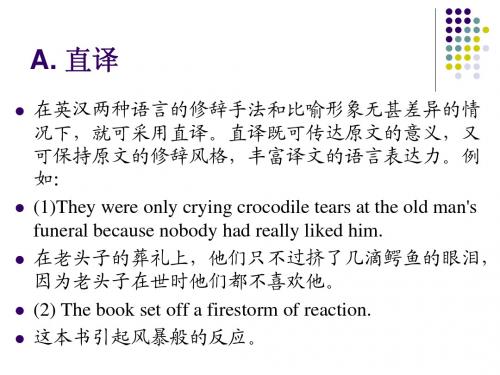
(3)He is the mouth of the House in its relations with the Crown. 他是议会对王室的发言人。(英语metonymy-汉语无修辞格) (4) Clearly a tug of war over key policies continues between the pragmatic and ideological camps. 不言而喻, 注重务实的和强调意识形态的两大 营垒还会在重大政策上争吵不休。(英语 metaphor--汉语无修辞格)
G.英语原文无修辞格,翻译成汉 语时用修辞格
有时原文中没有修辞格,但译成汉语时为了使 语言表达生动活泼,译文中可以适当增加汉语 修辞手法,例如: He determined to satisfy himself of the real state of the case. 他决心把事情弄个水落石出。
天哪,要是听信有些水手的胡说八道,你会以为每条 出海的船上都有该死的诺克斯堡哩。 (注:诺克斯堡是美国的一个军事保留地,是美国黄 金仓库的所在地。)
C. 释义
由于许多英语修辞手法或比喻形象本身是特有的,如 保留其形就会危害其义。如头韵法,其搭配可以千变 万化,很难碰巧找到相同的汉语搭配,即使勉强凑韵, 也不一定能表达原文的意思。 这时就必须首先保证 译文能正确传达原文的思想内容,然后再尽一切可能 去表现原文的节奏和旋律。 (1)They prolonged the clasp for the photographers, exchanging smiling words. 他们延长握手的时间,让摄影师照相,同时微笑着交 谈。(英语transferred epithet--汉语无修辞格) (2)You want your pound of flesh, don't you? 你要逼债,是吗?(英语allusion --汉语无修辞格)
汉英修辞对比与翻译_2_

直译法
1 比喻 时间是一条河,一条流在人们记忆里的 河,一条生命的河。--《芙蓉镇》 Time is a river, a river of life, flowing through men’s memories. --Tr. Gladys Yang
因此这李纨虽青春丧偶,且居于膏粱锦 绣之中,竟如槁木死灰一般,一概无闻 无见。
9 反语
什么?你把那花瓶打碎啦?好得很! What? You broke that vase? A fine thing! (Good for you!) 啊,没带零钱?当然咯,像您这样的绅士只带 大票子。 Oh, you haven’t change? Well, of course, I know that gentlemen like you carry only large notes.
13 排比
随着嘹亮的歌声,黑暗过去了,太阳出 山了,大地苏醒了,革命胜利了。 With the resonant song, the dark disappeared, the sun rose, the earth came around, and our revolution was crowned with victory.
The general lost the town and his head. 那位将军丢失了城池,也丢掉了脑袋。 Yesterday he had a blue heart and coat. 昨天他心情忧郁,穿着一件蓝色上衣。
She was dressed in a maid’s cap, a pinafore, and a bright smile. 她头戴一顶少女的帽子,腰系一条围裙,面带灿 烂的微笑。 Miss Bolo rose from the table considerably agitated, and went straight home in a flood of tears and sedan chair. 波洛小姐激动地从桌边座位上站起来,淌着热泪, 乘着轿子,径直回家。
英汉互译之修辞格的翻译
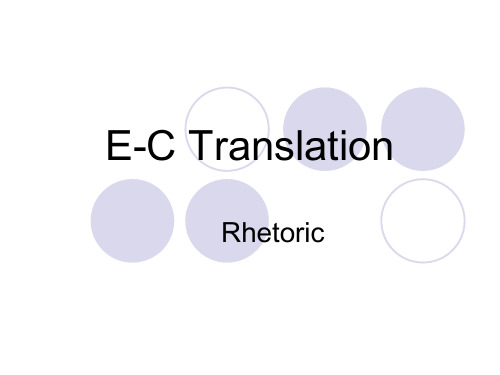
有时采用意译来翻译转喻更为合适 1) Great minds think alike. (= Great people think alike.) 英雄所见略同。(不宜译成 “伟大的脑袋 所见略同。”) 2) Gray hair should be respected. (gray hair = the aged) 老年人应受到尊敬。(不宜译成 “灰头发 应受到尊敬。”)
3) Her olfactory system was suffering from a temporary inconvenience. (= Her nose was blocked.) 她的嗅觉系统暂时有些不便。(=她鼻塞。) 4) His brother is a disturber of the piano keys. (= pianist) 他哥哥是一个跟钢琴键找麻烦的人。(=钢琴家) (这些折绕句有着幽默的效果。)
现在可知的汉语修辞手法有六十三大类,七十八小类。
常见修辞手法:
明喻;暗喻;拟人;夸张; 讳饰;转喻;省略;折绕; 移就;通感;呼告;递升; 递降;反语; 排比;设问; 反问;谲辞
1. 直译法 ——对可译的辞格,尽可能直译
明喻 Simile 1) 刘玉翠回到村里,就好比是住进了监牢里。 (康濯《春种秋收》) Having returned to the village,Liu Yucui felt as if she had got into prison. 2) He drove as if possessed by the devil. 他着魔似的驾车狂奔。
1) 每条岭都是那么温柔,虽然下自山脚,上至岭 顶,长满了珍贵的林木,可是谁也不孤峰突起, 盛气凌人。(老舍:《小花朵集》) All the ridges were so amiable. None of them stood above the others with arrogance, though their slopes were fully covered with precious trees.
英语修辞
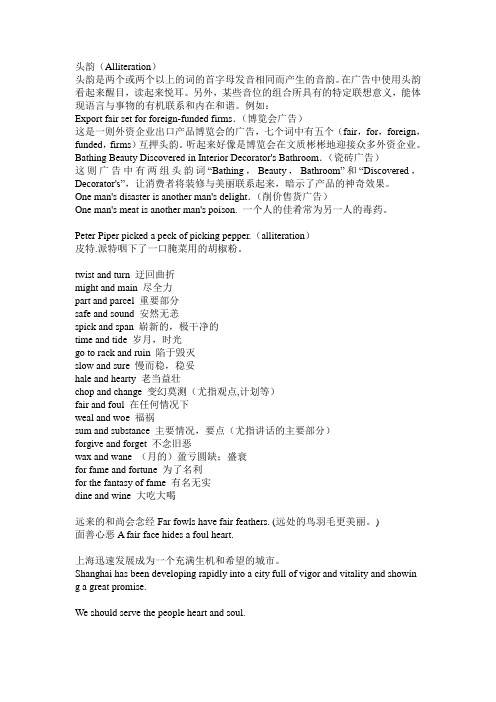
头韵(Alliteration)头韵是两个或两个以上的词的首字母发音相同而产生的音韵。
在广告中使用头韵看起来醒目,读起来悦耳。
另外,某些音位的组合所具有的特定联想意义,能体现语言与事物的有机联系和内在和谐。
例如:Export fair set for foreign-funded firms.(博览会广告)这是一则外资企业出口产品博览会的广告,七个词中有五个(fair,for,foreign,funded,firms)互押头韵。
听起来好像是博览会在文质彬彬地迎接众多外资企业。
Bathing Beauty Discovered in Interior Decorator's Bathroom.(瓷砖广告)这则广告中有两组头韵词“Bathing,Beauty,Bathroom”和“Discovered,Decorator's”,让消费者将装修与美丽联系起来,暗示了产品的神奇效果。
One man's disaster is another man's delight.(削价售货广告)One man's meat is another man's poison. 一个人的佳肴常为另一人的毒药。
Peter Piper picked a peck of picking pepper.(alliteration)皮特.派特咽下了一口腌菜用的胡椒粉。
twist and turn 迂回曲折might and main 尽全力part and parcel 重要部分safe and sound 安然无恙spick and span 崭新的,极干净的time and tide 岁月,时光go to rack and ruin 陷于毁灭slow and sure 慢而稳,稳妥hale and hearty 老当益壮chop and change 变幻莫测(尤指观点,计划等)fair and foul 在任何情况下weal and woe 福祸sum and substance 主要情况,要点(尤指讲话的主要部分)forgive and forget 不念旧恶wax and wane (月的)盈亏圆缺;盛衰for fame and fortune 为了名利for the fantasy of fame 有名无实dine and wine 大吃大喝远来的和尚会念经Far fowls have fair feathers. (远处的鸟羽毛更美丽。
《《夜莺》(第二—五章)中修辞格翻译的实践报告》范文
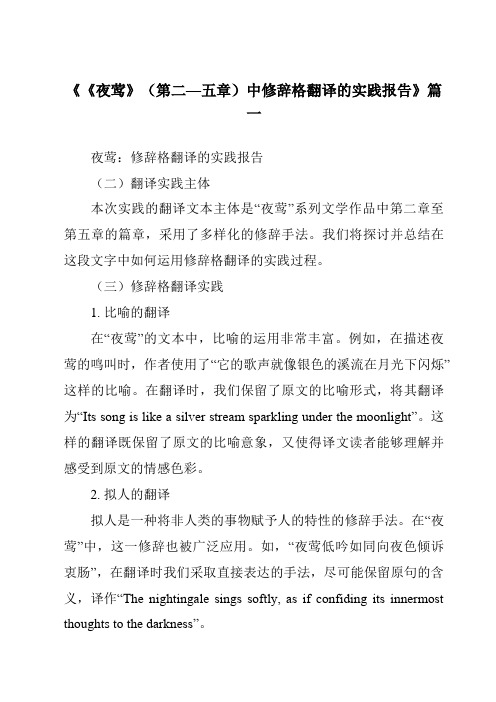
《《夜莺》(第二—五章)中修辞格翻译的实践报告》篇一夜莺:修辞格翻译的实践报告(二)翻译实践主体本次实践的翻译文本主体是“夜莺”系列文学作品中第二章至第五章的篇章,采用了多样化的修辞手法。
我们将探讨并总结在这段文字中如何运用修辞格翻译的实践过程。
(三)修辞格翻译实践1. 比喻的翻译在“夜莺”的文本中,比喻的运用非常丰富。
例如,在描述夜莺的鸣叫时,作者使用了“它的歌声就像银色的溪流在月光下闪烁”这样的比喻。
在翻译时,我们保留了原文的比喻形式,将其翻译为“Its song is like a silver stream sparkling under the moonlight”。
这样的翻译既保留了原文的比喻意象,又使得译文读者能够理解并感受到原文的情感色彩。
2. 拟人的翻译拟人是一种将非人类的事物赋予人的特性的修辞手法。
在“夜莺”中,这一修辞也被广泛应用。
如,“夜莺低吟如同向夜色倾诉衷肠”,在翻译时我们采取直接表达的手法,尽可能保留原句的含义,译作“The nightingale sings softly, as if confiding its innermost thoughts to the darkness”。
3. 排比的翻译排比是一种通过重复相同的句式或词汇来增强表达效果的修辞手法。
在“夜莺”的文本中,我们也发现了这一修辞的应用。
例如,“在夜幕降临的时候,星空灿烂如画卷,夜色浓重如漆画”。
我们选择在译文中也保留这一修辞手法,使译文的风格和原文保持一致,译作“As the night falls, the starry sky glows like a rolling scroll of paintings, while the darkness descends like a layer of dark oil painting”。
(四)翻译策略及实践反思在处理“夜莺”这一文学作品的翻译时,我们采用了灵活多变的翻译策略。
英语常用修辞格的翻译分析

quiet, light, fresh ,blind, clear, stubborn, cunning, old ,slippery, busy
明喻 Simile
英语中的simile和汉语明喻基本格式相同,一般情况下,可以照直翻译。as busy as bee 像蜜蜂一样忙碌as brave as lion 像狮子一样勇猛as black as crow 像乌鸦一般黑as sharp as knife 像刀一样锋利
英语比喻美感的再现应以比喻内容为基础,发掘比喻美的真正所在,同时致力于形式的表现,尽可能用“形神兼备”的翻译来传神达意。在实在不可能“形似”时,要在“神似”的条件下,竭力用其它方法和手段表现出原比喻的意之真谛、美之内涵。依据这一原则,可采用以下方法:
1 go to sleep in the presence of Mrs. General and blood was to change to milk and water. (Dickens. Little Dorrit) 在杰纳勒尔夫人跟前,一个人的激情会变得麻木不仁,热血也会变成掺了水的牛奶。
少时所学,到老不忘。我赚的不够吃。当我发了财时,我要到非洲去。每个人的生活都有甜有苦。
直译+意译法
1. Most of us are too ready to apply to others the cold wind of criticism, we are somehow reluctant to give our fellows the warm sunshine of praise. 我们中的很多人太容易给别人批评的冷风,而不愿意给自己的同伴赞扬的阳光。2. Men are April when they woo, December when they wed, maids are May when they maids, but the sky changes when they are wives. (Shakespeare) 男人求爱时如和煦的4月,婚后却像寒冬腊月;闺中少女则宛若温暖的5月,而为人妇后却像易变的天气阴晴莫测。
常见的修辞格翻译 (1)

他清清楚楚地看见一条丁字街,横在他 眼前。 He saw distinctly the cross-road ahead of him. After that long talk, Jim became the sun in her heart. 那次长谈之后,吉姆成了她心中的太阳。
权曰:“今听臣言,则西蜀有泰山之安, 不听臣言,则主公有累卵之危矣。” Huang Quan replied: “Heed my words and our rule can be secure as Mountain Tai. Heed them not and your own position will become as precarious as a pile of eggs. ”
With this faith we will be able to hoe out of the mountain of despair a stone of hope. With this faith we will be able to transform the jangling discords of our nation into a beautiful symphony of brotherhood. 抱有这个信念,我们就能从绝望之山凿出希望 之石。抱有这个信念,我们就能把我们这个民 族中那些刺耳的噪音变成一部歌颂手足之情的 美妙交响曲。
常见的修辞格翻译
一、比喻(figure of speech)
比喻无处不在,为各语言文化共有。 比喻有四个要素:本体(tenor),喻体 (vehicle),比喻词(comparative word)及相似点(point of resemblance)。这里主要谈谈明喻 (simile)和暗喻(metaphor)的翻译。
常见的修辞格翻译

一、比喻(figure of speech)
比喻无处不在,为各语言文化共有。 比喻有四个要素:本体(tenor),喻体 (vehicle),比喻词(comparative word)及相似点(point of resemblance)。这里主要谈谈明喻 (simile)和暗喻(metaphor)的翻译。
张飞听了,瞋目大叱曰:“我哥哥是金枝 玉叶,你是何等人,敢称我哥哥为贤弟! 你来!我和你斗三百合!” The moment Zhang Fei heard this, his eyes widened and he shouted, “Our brother is a prince of the blood, a jade leaf on the golden branch. Who are you to call him ‘young brother’? Come out now and fight three hundred rounds with me. ”
后曰:“旦夕如坐针毡,似此为人,不 如早亡!妾看宦官中之忠义可托者,莫 如穆顺,当令寄此书。” “Day and night we sit on pins,” the Empress continued. “I prefer death to a life like this. Among our eunuchs Mu Shun is loyal and true. He could deliver the letter.”
权曰:“今听臣言,则西蜀有泰山之安, 不听臣言,则主公有累卵之危矣。” Huang Quan replied: “Heed my words and our rule can be secure as Mountain Tai. Heed them not and your own position will become as precarious as a pile of eggs. ”
简述英语修辞格的运用及翻译
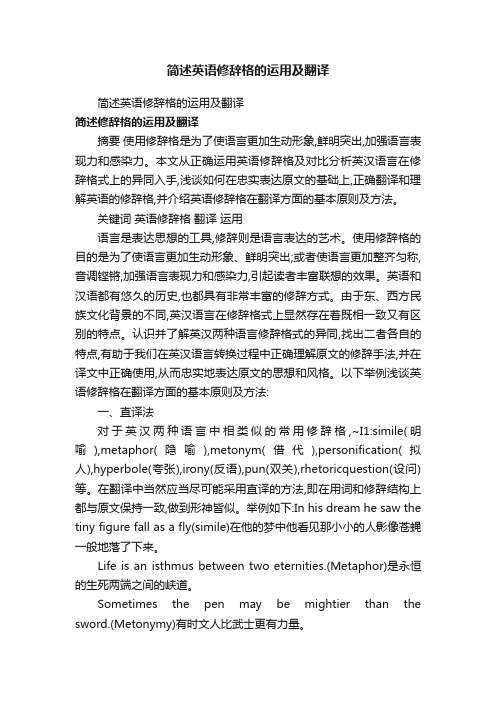
简述英语修辞格的运用及翻译简述英语修辞格的运用及翻译简述修辞格的运用及翻译摘要使用修辞格是为了使语言更加生动形象,鲜明突出,加强语言表现力和感染力。
本文从正确运用英语修辞格及对比分析英汉语言在修辞格式上的异同入手,浅谈如何在忠实表达原文的基础上,正确翻译和理解英语的修辞格,并介绍英语修辞格在翻译方面的基本原则及方法。
关键词英语修辞格翻译运用语言是表达思想的工具,修辞则是语言表达的艺术。
使用修辞格的目的是为了使语言更加生动形象、鲜明突出;或者使语言更加整齐匀称,音调铿锵,加强语言表现力和感染力,引起读者丰富联想的效果。
英语和汉语都有悠久的历史,也都具有非常丰富的修辞方式。
由于东、西方民族文化背景的不同,英汉语言在修辞格式上显然存在着既相一致又有区别的特点。
认识并了解英汉两种语言修辞格式的异同,找出二者各自的特点,有助于我们在英汉语言转换过程中正确理解原文的修辞手法,并在译文中正确使用,从而忠实地表达原文的思想和风格。
以下举例浅谈英语修辞格在翻译方面的基本原则及方法:一、直译法对于英汉两种语言中相类似的常用修辞格,~I1:simile(明喻),metaphor(隐喻),metonym(借代),personification(拟人),hyperbole(夸张),irony(反语),pun(双关),rhetoricquestion(设问)等。
在翻译中当然应当尽可能采用直译的方法,即在用词和修辞结构上都与原文保持一致,做到形神皆似。
举例如下:In his dream he saw the tiny figure fall as a fly(simile)在他的梦中他看见那小小的人影像苍蝇一般地落了下来。
Life is an isthmus between two eternities.(Metaphor)是永恒的生死两端之间的峡道。
Sometimes the pen may be mightier than the sword.(Metonymy)有时文人比武士更有力量。
- 1、下载文档前请自行甄别文档内容的完整性,平台不提供额外的编辑、内容补充、找答案等附加服务。
- 2、"仅部分预览"的文档,不可在线预览部分如存在完整性等问题,可反馈申请退款(可完整预览的文档不适用该条件!)。
- 3、如文档侵犯您的权益,请联系客服反馈,我们会尽快为您处理(人工客服工作时间:9:00-18:30)。
在例 2 中,greybeards 指代年纪大的人, 中,greybeards 但若译成“却不敢对一班白胡须讲真话 吗?”,就不符合汉语的表达习惯,因此 添加说明,译成“白须老头” 在例3 中,the 在例3 中,the little grey cells of the brain 指代大脑的思维,在这里直译译出,并不 妨碍理解。
1)On the 14th of March, at a quarter to three in the afternoon, the greatest living thinker ceased to think. He had been left alone for scarcely two think. minutes, and when we came back we found him in his armchair, peacefully gone to sleep—but forever. (Friederich Engels, Speech at the Graveside sleep— forever. of Karl Marx) Marx) 3 月14 日下午两点三刻,当代最伟大的思想家停止思想了。让他一个人留在 房间 里总共不过两分钟,我们再进去的时候,发现他在安乐椅上安详地睡着了— 里总共不过两分钟,我们再进去的时候,发现他在安乐椅上安详地睡着了— —永远 地睡着了。(石幼珊译) 2)You would no doubt wish me to make some slight allusion to this tragic domestic affliction next Sunday. (Oscar Wilde, The Importance of Being Earnest) Earnest) 您一定会希望我在下星期天的弥撒上稍稍提及这一悲剧性的家庭不幸。 3) The doctor was fiercely condemned by some for what he referred to as helping people in dying. 这位医生从事他所声称的“ 安乐死” ,为此遭到一些人的猛烈抨击。
排比 (Paralleli
夸张就是通过有意夸大或缩小事物的某个方面来增强语气,起到强调 的效果。这种修辞手法具有很强的感染力,在英汉语言中都很常见。 一般情况下,可以直译,以保持原文的艺术特色,使译文具有相同的 效果。例如: 1) “At 'em, all hands - all hands!” he roared, in a voice of thunder. (Robert Louis Stevenson, Treasure Island) Island) 他用雷鸣般的声音吼道:“抓住他们!给我上!都给我上!” 2)Yes, young men, Italy owes to you an undertaking which has merited the applause of the universe. (Guiseppe Garibaldi, To His Soldiers) Soldiers) 是的,年轻人,意大利由于有了你们,得以成就这项寰宇称颂的伟业。 (石幼珊译)
由于中英文表达习惯不同,并非所有拟人 都适合采用直译,有时候采用意译更会符 合译文语言表达习惯。 The ship sadly caught fire and the plans to make her a floating museum died in the smoldering embers. 这艘船不幸着火了,于是把它建成水上博 物馆的种种计划也在一片焖燃着的灰烬 中泡汤了。
2)You gave her good advice, and broke her heart. That was the beginning of your reformation. reformation. (Oscar Wilde, The Picture of Dorian Gray) Gray) 你给了她忠告,撕碎了她的心。你就是这样开始你所谓的 自我改造的。 3)You and the girls may go, or you may send them by themselves, which perhaps will be still better, for as you are as handsome as any of them, Mr. Bingley might like you the best of the party. (Jane Austin, Pride and party. Prejudice) Prejudice) 你带着女儿们去就行啦。要不干脆打发她们自己去,那样 没准更好些。要知道你的模样跟她们一样标致,宾利先生 兴许倒会看上你呢。
2)Have I in conquest stretch'd mine arm so far To be afeard to tell greybeards the truth? (Shakespeare, Julius Caesar) Caesar) 难道我南征北战,攻下了这许多地方, 却不敢对一班白须老头讲真话吗? (朱生豪译) 3)Only one thing will solve this case—the little grey case— cells of the brain. (Agartha Christie, Three Act Tragedy) Tragedy) 只有一样东西可以解决这个案子,那就是小小的灰色脑细 胞。
1)Yonder sky that has wept tears of compassion upon my people compassion for centuries untold, and which to us appears changeless and eternal, may change. (Chief Seattle, Reply to the U.S. Government) Government) 数不尽的世代以来,渺渺苍天曾为我族洒下多少同情之泪;这个在我 们看来像是 永恒不变的苍天,还是会变的。(石幼珊译) 2)To its residents, Vesuvius was a benefactor— not an enemy. But benefactor— without any warning, Mount Vesuvius roared to life. 对于附近居民来说,维苏威火山是恩人,而不是敌人。然而,在没有 任何预兆的情 况下,维苏威火山咆哮着苏醒了。
3)We must work to live, and they give us such mean wages that we die. (Oscar Wilde, The Young King) King) 我们不得不做工来养活自己,可是他们只给我们那么少的 工钱,我们简直活不下去。 (巴金译) 4)Nay, he said—yes you did—deny it if you can, that said— did— you would not have confessed the truth, though master had cut you to pieces. (Henry Fielding, The History of Tom Jones, A Foundling) Foundling) 他还说——你是这么说的,有本事你就抵赖好了。你还说, 他还说——你是这么说的,有本事你就抵赖好了。你还说, 就是老师把你剁成肉酱,你也绝不招出实情。(萧乾译)
反语 (Irony) Irony)
反语就是使用与本意相反的词句来表达本意,一般用于讽 刺嘲弄。为了保留原文的讽刺效果,通常采用直译的方法。 例如: 1)He stated a truth, and did it in such a pleasant way, and salved over my sore spot so gently and so healingly, that I was rather glad I had committed the crime, for the sake f the letter. (Mark Twain, Unconscious Plagiarism) Plagiarism) 他说出了一个真理,而且说得那么令人愉快,帮我顺顺当 当地下了台阶,使我甚至庆幸自己亏得犯了这剽窃罪,因 而得到了这封信。(石幼珊译)
拟人(Personification) 拟人(Personification)
拟人就是把动物和没有生命的事物当成有思想感 情的人类来描写,甚至让它们具有人的行为。这 些事物可以是无生命的实体,还可以是抽象的概 念, 如:a smiling moon(微笑的月亮),a 如:a moon(微笑的月亮),a crying city(哭泣的城市),to strangle justice city(哭泣的城市),to (扼杀正义)等。 英汉两种语言中都有这种修辞手法,在翻译的时 候一般可采取直译的方法再现原文的生动形象。
讳饰 (Euphemism) Euphemism)
讳饰就是用委婉语来取代令人不快的字句,这也是英 汉两种语言中共有的现象。如果在译入语中有字面上对应 的委婉语,如英语中的to 的委婉语,如英语中的to be no more 可与汉语中的“不 在了”、“没了”(讳饰“死”)对应,我们就应当采取 直译的办法。如果译入语中没有在字面上与原文对应的委 婉语,我们就应当采用功能上与之相等的委婉语。如英语 中的to 中的to be in a delicate condition 不可直译为“处于娇弱 的状态”,但是可以意译为“有喜”、“身怀六甲”(讳 饰 “怀孕”)等。翻译时应该尽量避免采用与原文所讳 饰的字句对应的语言进行翻译。例如原文中如使用to 饰的字句对应的语言进行翻译。例如原文中如使用to pass away(讳饰die),翻译时就不应该使用“死”一词,而 away(讳饰die),翻译时就不应该使用“死”一词,而 应该使用“去世”、“过世”等。又如,在讨论病人的情 况时,说到“他不行了”,可以用He 况时,说到“他不行了”,可以用He won’t make it 来译; 说到Seems 说到Seems he won’t survive tomorrow morning,则可以 morning,则可以 译为“看样子他过不了明天早晨”。
